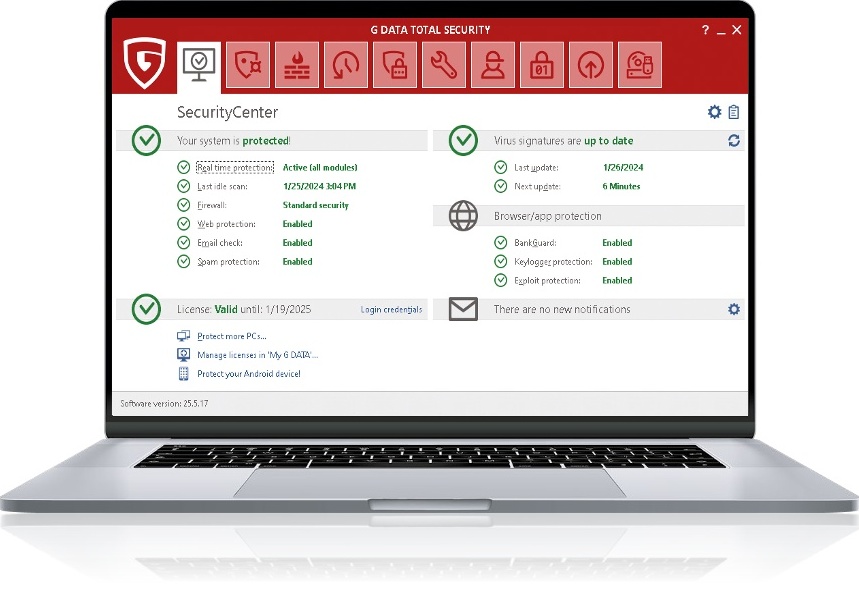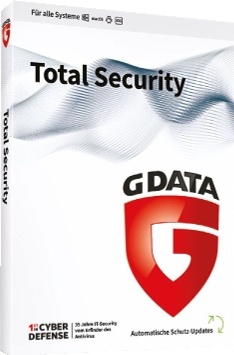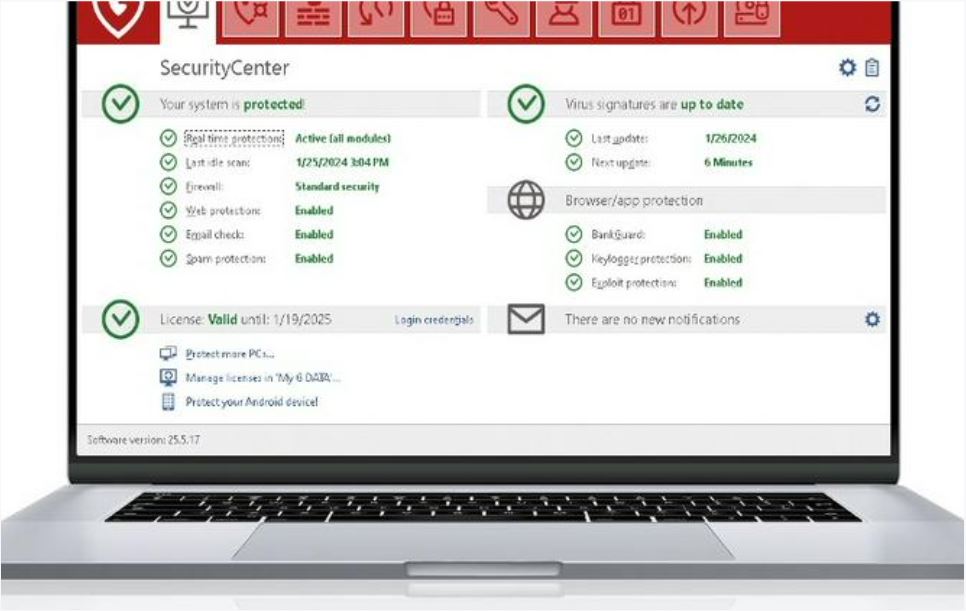Why you can trust TechRadar
This review first appeared in issue 355 of PC Pro.
If your priority is to stay safe, there are two good reasons to choose G Data Total Protection: its twin malware detection engines. G Data combines its own engine with Bitdefender’s, which is also a reliable performer, helping to keep those detection scores high.
It’s better known in its native Germany than in the UK, which is why it isn’t tested so widely; the UK-based SE Labs doesn’t test G Data, and even in AV-Test (based in Austria) we had to go back to February 2023 for results, where it provided 100% protection.
AV-Comparatives is based in Germany and unsurprisingly covers G Data much more frequently, and here it provided a strong set of scores, albeit not the best. Most recently, it returned a solid 99.6% protection rating with eight false positives. That’s just short of the clean sweep we saw last year, but if you’d spent the past 12 months using G Data then it’s very unlikely you will have experienced a malware infection.

There’s no shortage of scan options if you’re concerned. You can run or schedule a full malware scan, or scan specific files or directories, your computer’s memory and startup processes, removable media, and also check for rootkits. Other options under Virus Protection allow you to access quarantined files or burn a bootable rescue image to a CD or USB drive.
G Data Total Protection’s features haven’t changed in any major way since last year’s review, which is both good and bad. For example, it’s good that you’re prompted to install a plugin for Edge, but you’ll find references to Internet Explorer scattered throughout the G Data suite. Indeed, parts of the application feel oriented towards Windows operating systems that have been end-of-life for years, and include extra features that cater to older PC hardware configurations. Discontinued browsers, apps and web services appear in configuration settings and additional software tools, though the disk defragmenter at least automatically excludes drives that it detects to be SSDs. You can override this, but we strongly advise against it.
As we observed last year, the parental controls include an option to block all SSL sites, otherwise known as most of the modern internet. They otherwise work as you’d expect, but that’s still not as helpful as Microsoft Family Safety, unless you’d rather not create Microsoft accounts for your children. G Data’s password manager is particularly poor, minimally documented, and still only has plugins for Google Chrome and Internet Explorer. Use a dedicated password manager instead.

More sensibly, as many people are still on modest internet connections and need as few delays to their downloads as possible, only downloads of up to 10MB are checked by the G Data Web protection tool by default. The files will also be checked once they’ve been downloaded, but if you’ve got a fast PC and internet connection to match, you might want to disable this option.
G Data’s firewall is simple and easy to work with, and its default autopilot is hassle-free. The backup tool supports differential and incremental backups of any selected files and folders, on the schedule of your choice, to physical media, a network location or a synced storage drive.
Unexpectedly, if you’re in the UK, G Data will be sold to you in US dollars, which means $50 for a one-device subscription, $66 for three devices and $82 for five devices. Whether you buy from a third-party retailer (good luck) or from G Data directly, there are no hidden price hikes after the first year of subscription, which is a real strength compared to its rivals.

G Data Total Security is the premium version of the company’s antivirus software, available on Windows and macOS, with iOS and Android apps to go with it. However, we actually recommend that you buy G Data Internet Security ($40) instead, as this gets you the powerful antivirus engines, plus the firewall, quarantine, cross-platform protection and parental controls – without the performance tuning and encryption tools, or the clunky password manager. You miss out on the device access controls and backup tool, which is one of the best we’ve seen built into an AV suite, but let’s not forget that Duplicati is free.
In truth, we still find the client’s old-school looks rather endearing, and love all the little touches – such as USB keylogger detection and the ability to include only some of the security suite’s features at install time – but it could do with updates for the Windows 11 era (and Windows 10 era), particularly when it comes to its privacy tools.
Nonetheless, G Data provides straightforward, effective and inexpensive protection against malware and other threats to your system, making it one of our favorite security suites, despite its quirks.
We've also rated the best privacy tools and anonymous browsers.
K.G. is a journalist, technical writer, developer and software preservationist. Alongside the accumulated experience of over 20 years spent working with Linux and other free/libre/open source software, their areas of special interest include IT security, anti-malware and antivirus, VPNs, identity and password management, SaaS infrastructure and its alternatives.
K.G.'s tech writing has also appeared in PC Pro, WIRED, Trusted Reviews, The MagPi, Linux Journal, Expert Reviews and Wireframe, among others. Their broader professional background also includes anti-malware testing, IT and information security for large international organisations, documentation and tutorial writing, fiction, marketing and copywriting, Linux compatibility implementation and testing, and work within the video games industry.
What is a hands on review?
Hands on reviews' are a journalist's first impressions of a piece of kit based on spending some time with it. It may be just a few moments, or a few hours. The important thing is we have been able to play with it ourselves and can give you some sense of what it's like to use, even if it's only an embryonic view. For more information, see TechRadar's Reviews Guarantee.
You must confirm your public display name before commenting
Please logout and then login again, you will then be prompted to enter your display name.

